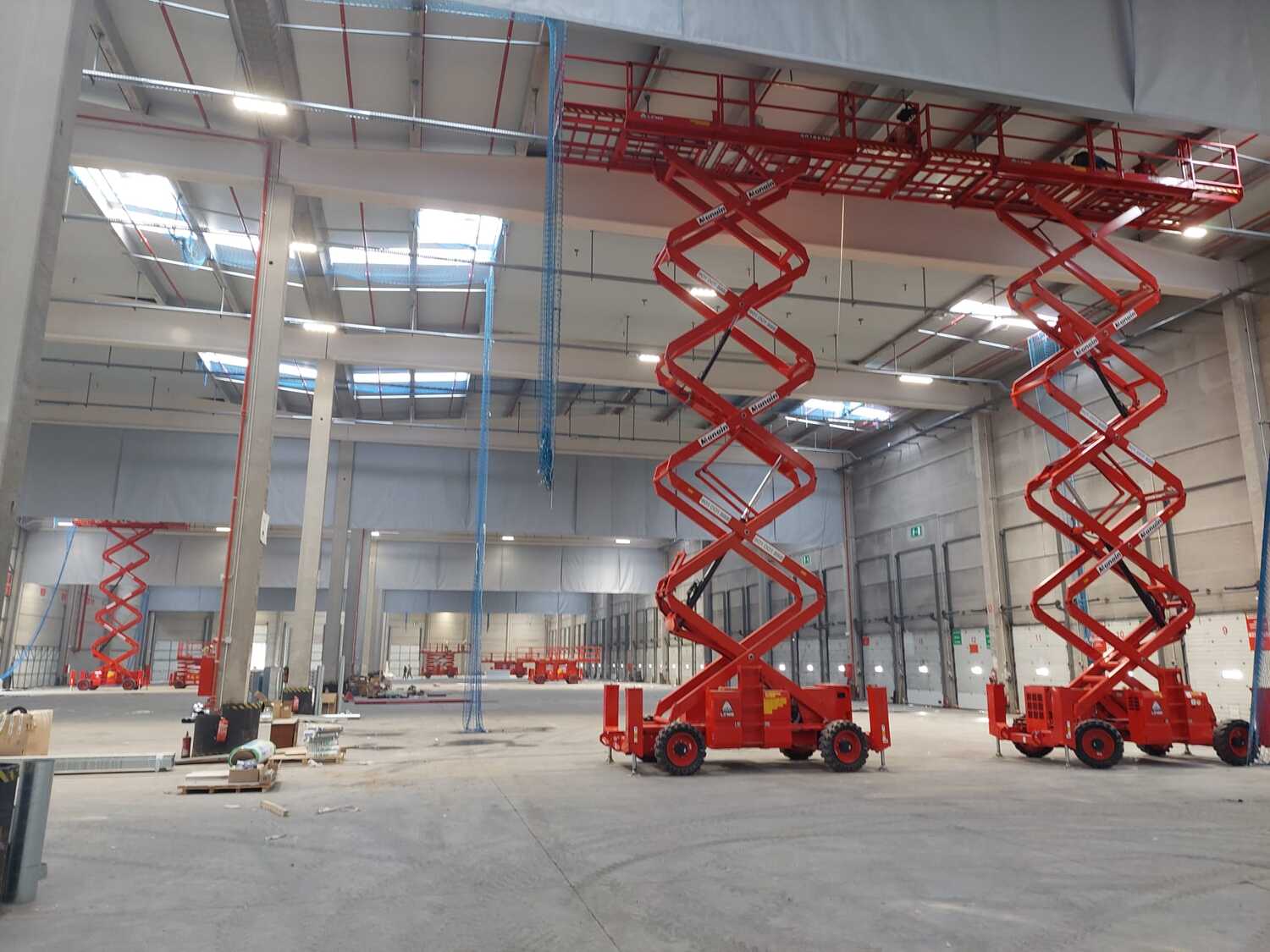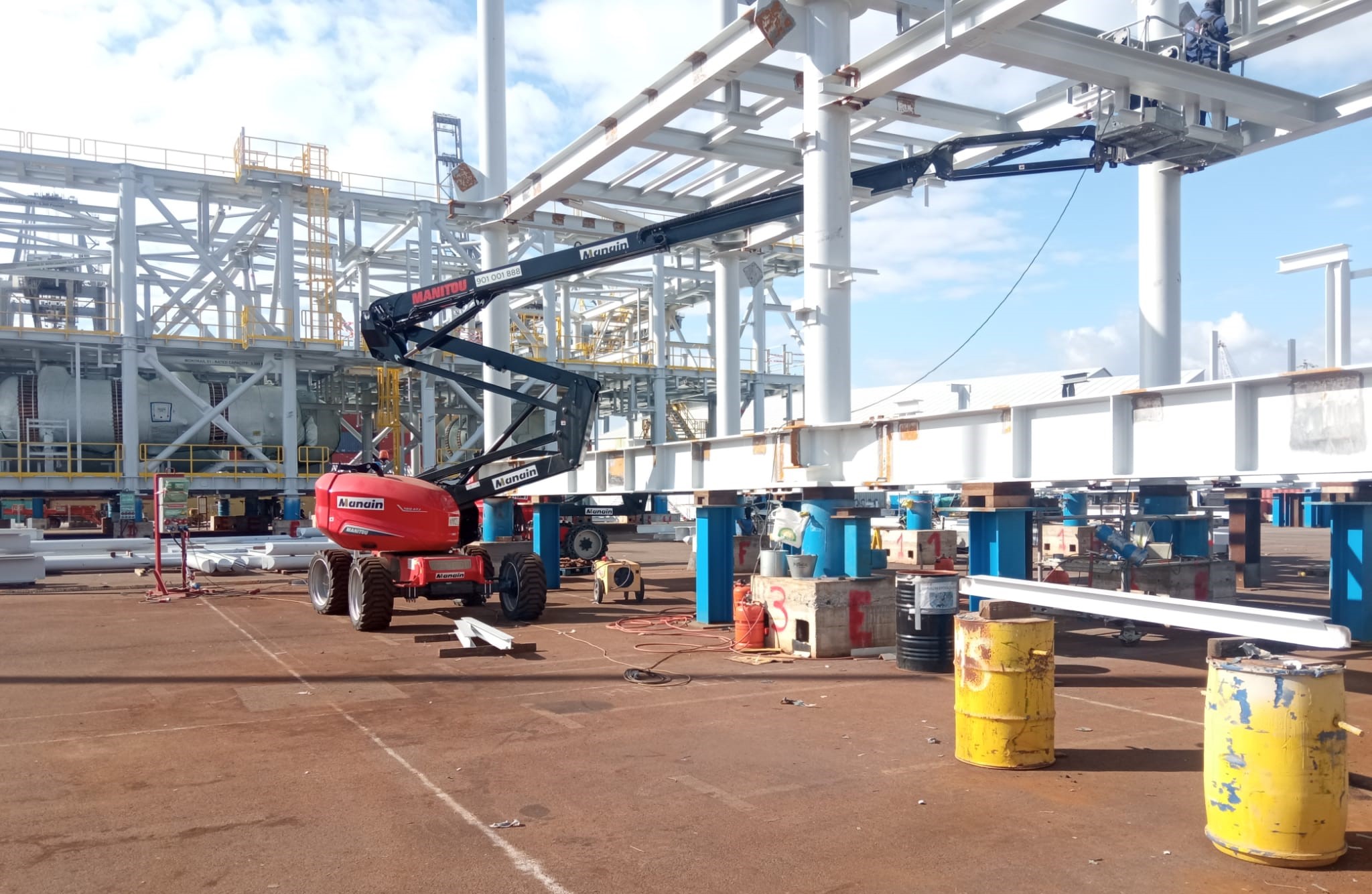There are different uses for aerial work platforms. Although it might not seem obvious, their great versatility makes them indispensable for a wide variety of tasks. In some environments, using them can even be beneficial as it allows workers to act efficiently and follow higher safety standards. Here are the 10 most common functions for performing these tasks. But if we take a closer look, there’s a long list of their uses.
1. In construction and renovation
Aerial work platforms in the field of new construction as well as building repair and maintenance are varied in their uses. They safely, cost-effectively, quickly, and comfortably elevate workers, materials, machinery, and tools. Articulating and telescoping platforms are mainly used due to their versatility for working from the platform itself or accessing the tops of buildings and terraces. Scissor lifts can also be used depending on the work area, such as facades or material loading tasks, as they provide a larger work area and higher load capacity.

2. In public or private outdoor lighting
Another frequent function of aerial platforms is to perform tasks like installing or placing outdoor lighting and repairing electrical and telephone lines. Streetlights, advertising lighting, or artistic lighting on buildings are some examples. Articulating or telescoping arms allow access to the work position. Bucket trucks are also an option for this type of task.

3. Tree pruning at height
Some trees are too tall to be pruned safely, efficiently, and profitably from the ground or with a ladder. From the aerial platform, cutting tools can be operated at height safely for the benefit of the tree and the safety of the public. In some agricultural areas, platforms are also used for fruit harvesting. Articulated platforms or truck-mounted bucket lifts are ideal for performing these tasks due to their movement versatility at height.

4. Window cleaning and repairs
Aerial platforms can greatly increase efficiency in window cleaning. Instead of using scaffolding that requires time and effort to set up or hanging from a harness, workers can be elevated directly to the work point using scissor, articulating, or telescoping lifts.
In both public and private buildings, cleaning gutters is a key task to prevent pest nesting, dirt buildup, and blockages that could obstruct the normal flow of rainwater. Easy access to high gutters for workers and their professional tools is essential for these tasks.

5. In warehouses and logistics centers
Aerial platforms play a fundamental role in logistics warehouses and commercial storage. Electric models offer the dual function of reducing carbon and noise emissions. The compact size and turning angle of platforms provide great mobility in narrow warehouse aisles.
Additionally, another popular option for these types of facilities are low-level or single-person platforms. These provide safety and efficiency compared to ladders or scaffolding. Electric low-level scissors lifts, such as the LGMG 0407 and 0507 models, can also be an option.

6. In building inspections
Tall buildings require strict periodic inspections to detect potential faults that could lead to larger problems in the future.
Thanks to articulated platforms, inspectors can safely and efficiently access roofs, windows, electrical, water, and gas systems, as well as heating systems, without the need for scaffolding or ladders.

7. In painting and restoration
Restoring and painting buildings require aerial platforms to make tasks more accessible without the need to move the platform back and forth. Both articulating, telescoping, and scissor platforms can be used to improve work efficiency and increase productivity, ensuring worker safety.

8. In sports events
Another use for aerial platforms is in the maintenance and improvements of stadiums and sports fields, as well as the installation of TV equipment that covers games and matches. In this case, articulating or telescoping platforms can be used.

9. In the installation of signs and advertisements
Among the tasks of aerial platforms, installing signs, advertisements, and stickers on billboards is a common function. It is recommended to choose an articulating aerial platform, as many times work is done on uneven terrain, and these provide greater stability for safe work.
The same applies to the installation and removal of Christmas decorations, public holiday decorations, or decorations for weddings and other events. They are also used for replacing elements like building sconces, bulbs, or window grills at height. In these situations, bucket trucks can also be an option for installation.

10. Structure assembly
Another key function of aerial platforms is providing machinery for assembling structures. Both in industry and outdoors, from scissor lifts to articulating or telescoping platforms can be used to assemble concert stages and other types of structures.

Other functions of aerial platforms
They can also be used for other work-at-height tasks, such as video production for aerial shots, restoration and cleaning of artworks, including sculptures, outdoor art installations, or artistic facades, to speed up and improve efficiency from an aerial platform.
Aerial platforms are often used for tasks that were once only possible with ladders and scaffolding. Thanks to technology, platforms have been integrated into various sectors offering versatility and safety.
For this and other uses, it is common for companies to buy or rent an aerial platform suitable for the required working height. If you need information for your next operation, feel free to contact us at [email protected].



















